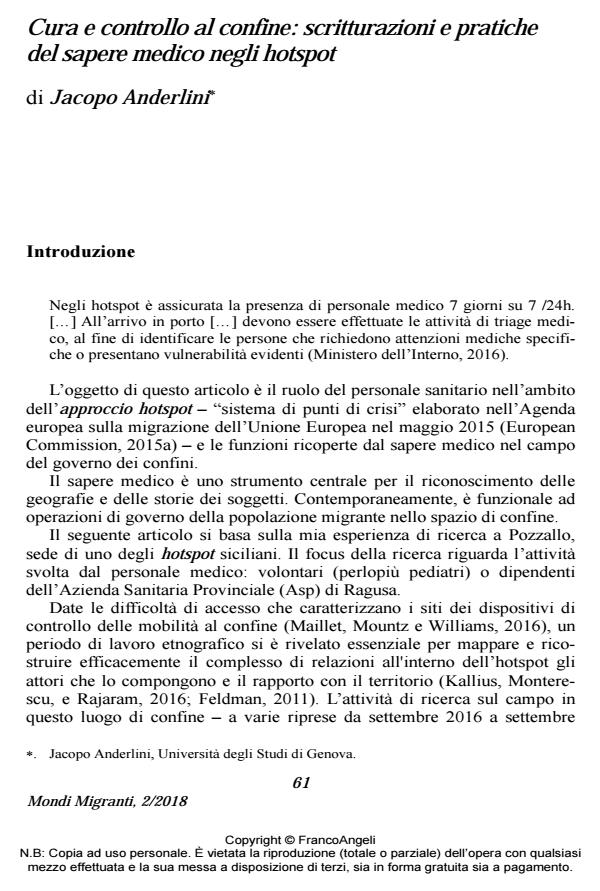Care and Control at the Border: Documents and Practices of Medical Knowledge within the Hotspots
Journal title MONDI MIGRANTI
Author/s Jacopo Anderlini
Publishing Year 2018 Issue 2018/2
Language Italian Pages 20 P. 61-80 File size 208 KB
DOI 10.3280/MM2018-002004
DOI is like a bar code for intellectual property: to have more infomation
click here
Below, you can see the article first page
If you want to buy this article in PDF format, you can do it, following the instructions to buy download credits

FrancoAngeli is member of Publishers International Linking Association, Inc (PILA), a not-for-profit association which run the CrossRef service enabling links to and from online scholarly content.
Starting from its definition in the 2015 European Agenda on Migration, the "hotspot approach" has been adopted in different border zones within the Euro-pean boundaries. This specific border dispositive is framed within the discourses on security and humanitarianism, depicting what William Walters (2011) defines as the "humanitarian border". Focusing on the role of the medical expertise, the article examines procedures and practices at work inside the hotspot. The functions of identification, classification and selection characterize this border technology as a filter to decelerate, block, reroute mobility trajectories. Based on a research fieldwork on the hotspot of Pozzallo, Italy, the contribution examines - through ethnographical fieldwork, in-depth interviews and analysis of bureaucratic artefacts - the activities of medical staff, their experiences and inter-actions within this complex border assemblage. The function of the medical exper-tise is thus unveiled as a biopolitical tool to bodies’ governance, in its double di-mension of care and control. Concurrently, the "doctor-patient" relationship could give space to enact counter tactics by the subjects captured in this border technol-ogy.
Keywords: Hotspot; humanitarian border; ethnography; border regime; humanitari-anism.
- Humanitarian border: Reprise. Anti-human trafficking discourses and security practices at the southern Italian border Jacopo Anderlini, in Environment and Planning C: Politics and Space /2025 pp.468
DOI: 10.1177/23996544241259576 - Migration, Borders and Citizenship Luca Giliberti, Luca Queirolo Palmas, pp.109 (ISBN:978-3-030-22156-0)
Jacopo Anderlini, Cura e controllo al confine: scritturazioni e pratiche del sapere medico negli hotspot in "MONDI MIGRANTI" 2/2018, pp 61-80, DOI: 10.3280/MM2018-002004